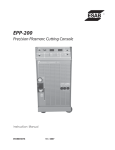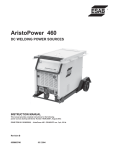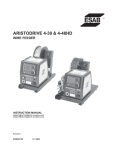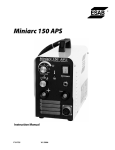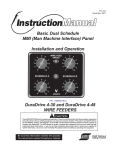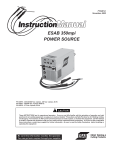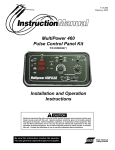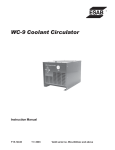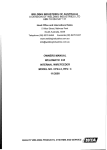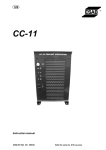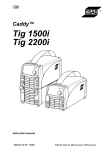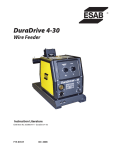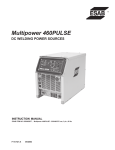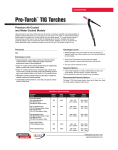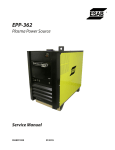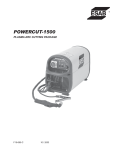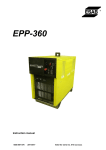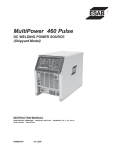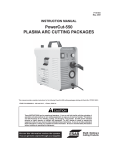Download F15-655-E Heliarc 161 - ESAB Welding & Cutting Products
Transcript
Heliarc 161 POWER SOURCE INSTRUCTION MANUAL P/N 0558002625 - 208 and 230 V, 1-Phase, 50/60 Hz F15-655-E 12 / 2003 BE SURE THIS INFORMATION REACHES THE OPERATOR. YOU CAN GET EXTRA COPIES THROUGH YOUR SUPPLIER. These INSTRUCTIONS are for experienced operators. If you are not fully familiar with the principles of operation and safe practices for arc welding and cutting equipment, we urge you to read our booklet, "Precautions and Safe Practices for Arc Welding, Cutting, and Gouging," Form 52-529. Do NOT permit untrained persons to install, operate, or maintain this equipment. Do NOT attempt to install or operate this equipment until you have read and fully understand these instructions. If you do not fully understand these instructions, contact your supplier for further information. Be sure to read the Safety Precautions before installing or operating this equipment. USER RESPONSIBILITY This equipment will perform in conformity with the description thereof contained in this manual and accompanying labels and/or inserts when installed, operated, maintained and repaired in accordance with the instructions provided. This equipment must be checked periodically. Malfunctioning or poorly maintained equipment should not be used. Parts that are broken, missing, worn, distorted or contaminated should be replaced immediately. Should such repair or replacement become necessary, the manufacturer recommends that a telephone or written request for service advice be made to the Authorized Distributor from whom it was purchased. This equipment or any of its parts should not be altered without the prior written approval of the manufacturer. The user of this equipment shall have the sole responsibility for any malfunction which results from improper use, faulty maintenance, damage, improper repair or alteration by anyone other than the manufacturer or a service facility designated by the manufacturer. 2 TABLE OF CONTENTS SECTION TITLE PAGE SECTION 1 GENERAL ........................................................................................................ 11 SECTION 2 INSTALLATION ................................................................................................ 13 SECTION 3 OPERATION ..................................................................................................... 17 SECTION 4 MAINTENANCE ............................................................................................... 21 SECTION 5 TROUBLESHOOTING ..................................................................................... 23 SECTION 6 REPLACEMENT PARTS .................................................................................. 25 3 TABLE OF CONTENTS 4 SAFETY PRECAUTIONS WARNING: These Safety Precautions are for your protection. They summarize precautionary information from the references listed in Additional Safety Information section. Before performing any installation or operating procedures, be sure to read and follow the safety precautions listed below as well as all other manuals, material safety data sheets, labels, etc. Failure to observe Safety Precautions can result in injury or death. 5. Do not use equipment beyond its ratings. For example, overloaded welding cable can overheat and create a fire hazard. 6. After completing operations, inspect the work area to make certain there are no hot sparks or hot metal which could cause a later fire. Use fire watchers when necessary. 7. For additional information, refer to NFPA Standard 51B, "Fire Prevention in Use of Cutting and Welding Processes", available from the National Fire Protection Association, Batterymarch Park, Quincy, MA 02269. PROTECT YOURSELF AND OTHERS -Some welding, cutting, and gouging processes are noisy and require ear protection. The arc, like the sun, emits ultraviolet (UV) and other radiation and can injure skin and eyes. Hot metal can cause burns. Training in the proper use of the processes and equipment is essential to prevent accidents. Therefore: ELECTRICAL SHOCK -- Contact with live electrical parts and ground can cause severe injury or death. DO NOT use AC welding current in damp areas, if movement is confined, or if there is danger of falling. 1. Be sure the power source frame (chassis) is connected to the ground system of the input power. 2. Connect the workpiece to a good electrical ground. 3. Connect the work cable to the workpiece. A poor or missing connection can expose you or others to a fatal shock. 4. Use well-maintained equipment. Replace worn or damaged cables. 5. Keep everything dry, including clothing, work area, cables, torch/electrode holder, and power source. 6. Make sure that all parts of your body are insulated from work and from ground. 7. Do not stand directly on metal or the earth while working in tight quarters or a damp area; stand on dry boards or an insulating platform and wear rubber-soled shoes. 8. Put on dry, hole-free gloves before turning on the power. 9. Turn off the power before removing your gloves. 10. Refer to ANSI/ASC Standard Z49.1 (listed on next page) for specific grounding recommendations. Do not mistake the work lead for a ground cable. 1. Always wear safety glasses with side shields in any work area, even if welding helmets, face shields, and goggles are also required. 2. Use a face shield fitted with the correct filter and cover plates to protect your eyes, face, neck, and ears from sparks and rays of the arc when operating or observing operations. Warn bystanders not to watch the arc and not to expose themselves to the rays of the electric-arc or hot metal. 3. Wear flameproof gauntlet type gloves, heavy long-sleeve shirt, cuffless trousers, high-topped shoes, and a welding helmet or cap for hair protection, to protect against arc rays and hot sparks or hot metal. A flameproof apron may also be desirable as protection against radiated heat and sparks. 4. Hot sparks or metal can lodge in rolled up sleeves, trouser cuffs, or pockets. Sleeves and collars should be kept buttoned, and open pockets eliminated from the front of clothing 5. Protect other personnel from arc rays and hot sparks with a suitable non-flammable partition or curtains. 6. Use goggles over safety glasses when chipping slag or grinding. Chipped slag may be hot and can fly far. Bystanders should also wear goggles over safety glasses. ELECTRIC AND MAGNETIC FIELDS — May be dangerous. Electric current flowing through any conductor causes localized Electric and Magnetic Fields (EMF). Welding and cutting current creates EMF around welding cables and welding machines. Therefore: FIRES AND EXPLOSIONS -- Heat from flames and arcs can start fires. Hot slag or sparks can also cause fires and explosions. Therefore: 1. Remove all combustible materials well away from the work area or cover the materials with a protective nonflammable covering. Combustible materials include wood, cloth, sawdust, liquid and gas fuels, solvents, paints and coatings, paper, etc. 2. Hot sparks or hot metal can fall through cracks or crevices in floors or wall openings and cause a hidden smoldering fire or fires on the floor below. Make certain that such openings are protected from hot sparks and metal.“ 3. Do not weld, cut or perform other hot work until the workpiece has been completely cleaned so that there are no substances on the workpiece which might produce flammable or toxic vapors. Do not do hot work on closed containers. They may explode. 4. Have fire extinguishing equipment handy for instant use, such as a garden hose, water pail, sand bucket, or portable fire extinguisher. Be sure you are trained in its use. 1. Welders having pacemakers should consult their physician before welding. EMF may interfere with some pacemakers. 2. Exposure to EMF may have other health effects which are unknown. 3. Welders should use the following procedures to minimize exposure to EMF: A. Route the electrode and work cables together. Secure them with tape when possible. B. Never coil the torch or work cable around your body. C. Do not place your body between the torch and work cables. Route cables on the same side of your body. D. Connect the work cable to the workpiece as close as possible to the area being welded. E. Keep welding power source and cables as far away from your body as possible. 5 SAFETY PRECAUTIONS EQUIPMENT MAINTENANCE -- Faulty or improperly maintained equipment can cause injury or death. Therefore: FUMES AND GASES -- Fumes and gases, can cause discomfort or harm, particularly in confined spaces. Do not breathe fumes and gases. Shielding gases can cause asphyxiation. Therefore: 1. Always have qualified personnel perform the installation, troubleshooting, and maintenance work. Do not perform any electrical work unless you are qualified to perform such work. 2. Before performing any maintenance work inside a power source, disconnect the power source from the incoming electrical power. 3. Maintain cables, grounding wire, connections, power cord, and power supply in safe working order. Do not operate any equipment in faulty condition. 4. Do not abuse any equipment or accessories. Keep equipment away from heat sources such as furnaces, wet conditions such as water puddles, oil or grease, corrosive atmospheres and inclement weather. 5. Keep all safety devices and cabinet covers in position and in good repair. 6. Use equipment only for its intended purpose. Do not modify it in any manner. 1. Always provide adequate ventilation in the work area by natural or mechanical means. Do not weld, cut, or gouge on materials such as galvanized steel, stainless steel, copper, zinc, lead, beryllium, or cadmium unless positive mechanical ventilation is provided. Do not breathe fumes from these materials. 2. Do not operate near degreasing and spraying operations. The heat or arc rays can react with chlorinated hydrocarbon vapors to form phosgene, a highly toxic gas, and other irritant gases. 3. If you develop momentary eye, nose, or throat irritation while operating, this is an indication that ventilation is not adequate. Stop work and take necessary steps to improve ventilation in the work area. Do not continue to operate if physical discomfort persists. 4. Refer to ANSI/ASC Standard Z49.1 (see listing below) for specific ventilation recommendations. 5. WARNING: This product, when used for welding or cutting, produces fumes or gases which contain chemicals known to the State of California to cause birth defects and, in some cases, cancer. (California Health & Safety Code §25249.5 et seq.) ADDITIONAL SAFETY INFORMATION -- For more information on safe practices for electric arc welding and cutting equipment, ask your supplier for a copy of "Precautions and Safe Practices for Arc Welding, Cutting and Gouging", Form 52-529. The following publications, which are available from the American Welding Society, 550 N.W. LeJuene Road, Miami, FL 33126, are recommended to you: 1. ANSI/ASC Z49.1 - "Safety in Welding and Cutting" 2. AWS C5.1 - "Recommended Practices for Plasma Arc Welding" 3. AWS C5.2 - "Recommended Practices for Plasma Arc Cutting" 4. AWS C5.3 - "Recommended Practices for Air Carbon Arc Gouging and Cutting" 5. AWS C5.5 - "Recommended Practices for Gas Tungsten Arc Welding“ 6. AWS C5.6 - "Recommended Practices for Gas Metal Arc Welding"“ 7. AWS SP - "Safe Practices" - Reprint, Welding Handbook. 8. ANSI/AWS F4.1, "Recommended Safe Practices for Welding and Cutting of Containers That Have Held Hazardous Substances." CYLINDER HANDLING -- Cylinders, if mishandled, can rupture and violently release gas. Sudden rupture of cylinder, valve, or relief device can injure or kill. Therefore: 1. Use the proper gas for the process and use the proper pressure reducing regulator designed to operate from the compressed gas cylinder. Do not use adaptors. Maintain hoses and fittings in good condition. Follow manufacturer's operating instructions for mounting regulator to a compressed gas cylinder. 2. Always secure cylinders in an upright position by chain or strap to suitable hand trucks, undercarriages, benches, walls, post, or racks. Never secure cylinders to work tables or fixtures where they may become part of an electrical circuit. 3. When not in use, keep cylinder valves closed. Have valve protection cap in place if regulator is not connected. Secure and move cylinders by using suitable hand trucks. Avoid rough handling of cylinders. 4. Locate cylinders away from heat, sparks, and flames. Never strike an arc on a cylinder. 5. For additional information, refer to CGA Standard P-1, "Precautions for Safe Handling of Compressed Gases in Cylinders", which is available from Compressed Gas Association, 1235 Jefferson Davis Highway, Arlington, VA 22202. MEANING OF SYMBOLS - As used throughout this manual: Means Attention! Be Alert! Your safety is involved. Means immediate hazards which, if not avoided, will result in immediate, serious personal injury or loss of life. Means potential hazards which could result in personal injury or loss of life. Means hazards which could result in minor personal injury. 6 PRECAUCION DE SEGURIDAD el calor causado por cable sobrecarga en los cables de soldar pueden ocasionar un fuego. 6. Después de termirar la operación del equipo, inspeccione el área de trabajo para cerciorarse de que las chispas o metal caliente ocasionen un fuego más tarde. Tenga personal asignado para vigilar si es necesario. 7. Para información adicional , haga referencia a la publicación NFPA Standard 51B, "Fire Prevention in Use of Cutting and Welding Processes", disponible a través de la National Fire Protection Association, Batterymarch Park, Quincy, MA 02269. ADVERTENCIA: Estas Precauciones de Seguridad son para su protección. Ellas hacen resumen de información proveniente de las referencias listadas en la sección "Información Adicional Sobre La Seguridad". Antes de hacer cualquier instalación o procedimiento de operación , asegúrese de leer y seguir las precauciones de seguridad listadas a continuación así como también todo manual, hoja de datos de seguridad del material, calcomanias, etc. El no observar las Precauciones de Seguridad puede resultar en daño a la persona o muerte. PROTEJASE USTED Y A LOS DEMAS-Algunos procesos de soldadura, corte y ranurado son ruidosos y requiren protección para los oídos. El arco, como el sol , emite rayos ultravioleta (UV) y otras radiaciones que pueden dañar la piel y los ojos. El metal caliente causa quemaduras. EL entrenamiento en el uso propio de los equipos y sus procesos es esencial para prevenir accidentes. Por lo tanto: CHOQUE 1. Asegúrese de que el chasis de la fuente de poder esté conectado 1. Utilice gafas de seguridad con protección a los lados siempre 2. 3. 4. 5. 6. a tierra através del sistema de electricidad primario. 2. Conecte la pieza de trabajo a un buen sistema de tierra física. 3. Conecte el cable de retorno a la pieza de trabajo. Cables y conductores expuestos o con malas conexiones pueden exponer al operador u otras personas a un choque eléctrico fatal. 4. Use el equipo solamente si está en buenas condiciones. Reemplaze cables rotos, dañados o con conductores expuestos. 5. Mantenga todo seco, incluyendo su ropa, el área de trabajo, los cables, antorchas, pinza del electrodo, y la fuente de poder. 6. Asegúrese que todas las partes de su cuerpo están insuladas de ambos, la pieza de trabajo y tierra. 7. No se pare directamente sobre metal o tierra mientras trabaja en lugares estrechos o áreas húmedas; trabaje sobre un pedazo de madera seco o una plataforma insulada y use zapatos con suela de goma. 8. Use guantes secos y sin agujeros antes de energizar el equipo. 9. Apage el equipo antes de quitarse sus guantes. 10. Use como referencia la publicación ANSI/ASC Standard Z49.1 (listado en la próxima página) para recomendaciones específicas de como conectar el equipo a tierra. No confunda el cable de soldar a la pieza de trabajo con el cable a tierra. que esté en el área de trabajo, aún cuando esté usando careta de soldar, protector para su cara u otro tipo de protección. Use una careta que tenga el filtro correcto y lente para proteger sus ojos, cara, cuello, y oídos de las chispas y rayos del arco cuando se esté operando y observando las operaciones. Alerte a todas las personas cercanas de no mirar el arco y no exponerse a los rayos del arco eléctrico o el metal fundido. Use guantes de cuero a prueba de fuego, camisa pesada de mangas largas, pantalón de ruedo liso, zapato alto al tobillo, y careta de soldar con capucha para el pelo, para proteger el cuerpo de los rayos y chispas calientes provenientes del metal fundido. En ocaciones un delantal a prueba de fuego es necesario para protegerse del calor radiado y las chispas. Chispas y partículas de metal caliente puede alojarse en las mangas enrolladas de la camisa , el ruedo del pantalón o los bolsillos. Mangas y cuellos deberán mantenerse abotonados, bolsillos al frente de la camisa deberán ser cerrados o eliminados. Proteja a otras personas de los rayos del arco y chispas calientes con una cortina adecuada no-flamable como división. Use careta protectora además de sus gafas de seguridad cuando esté removiendo escoria o puliendo. La escoria puede estar caliente y desprenderse con velocidad. Personas cercanas deberán usar gafas de seguridad y careta protectora. CAMPOS ELECTRICOS Y MAGNETICOS - Son peligrosos. La corriente eléctrica fluye através de cualquier conductor causando a nivel local Campos Eléctricos y Magnéticos (EMF). Las corrientes en el área de corte y soldadura, crean EMF alrrededor de los cables de soldar y las maquinas. Por lo tanto: 1. Soldadores u Operadores que use marca- FUEGO Y EXPLOSIONES -- El calor de las flamas y el arco pueden ocacionar fuegos. Escoria caliente y las chispas pueden causar fuegos y explosiones. Por lo tanto: 1. Remueva todo material combustible lejos del área de trabajo o 2. 3. 4. 5. cubra los materiales con una cobija a prueba de fuego. Materiales combustibles incluyen madera, ropa, líquidos y gases flamables, solventes, pinturas, papel, etc. Chispas y partículas de metal pueden introducirse en las grietas y agujeros de pisos y paredes causando fuegos escondidos en otros niveles o espacios. Asegúrese de que toda grieta y agujero esté cubierto para proteger lugares adyacentes contra fuegos. No corte, suelde o haga cualquier otro trabajo relacionado hasta que la pieza de trabajo esté totalmente limpia y libre de substancias que puedan producir gases inflamables o vapores tóxicos. No trabaje dentro o fuera de contenedores o tanques cerrados. Estos pueden explotar si contienen vapores inflamables. Tenga siempre a la mano equipo extintor de fuego para uso instantáneo, como por ejemplo una manguera con agua, cubeta con agua, cubeta con arena, o extintor portátil. Asegúrese que usted esta entrenado para su uso. No use el equipo fuera de su rango de operación. Por ejemplo, ELECTRICO -- El contacto con las partes eléctricas energizadas y tierra puede causar daño severo o muerte. NO use soldadura de corriente alterna (AC) en áreas húmedas, de movimiento confinado en lugares estrechos o si hay posibilidad de caer al suelo. pasos para el corazón deberán consultar a su médico antes de soldar. El Campo Electromagnético (EMF) puede interferir con algunos marca-pasos. 2. Exponerse a campos electromagnéticos (EMF) puede causar otros efectos de salud aún desconocidos. 3. Los soldadores deberán usar los siguientes procedimientos para minimizar exponerse al EMF: A. Mantenga el electrodo y el cable a la pieza de trabajo juntos, hasta llegar a la pieza que usted quiere soldar. Asegúrelos uno junto al otro con cinta adhesiva cuando sea posible. B. Nunca envuelva los cables de soldar alrededor de su cuerpo. C. Nunca ubique su cuerpo entre la antorcha y el cable, a la pieza de trabajo. Mantega los cables a un sólo lado de su cuerpo. D. Conecte el cable de trabajo a la pieza de trabajo lo más cercano posible al área de la soldadura. E. Mantenga la fuente de poder y los cables de soldar lo más lejos posible de su cuerpo. 7 PRECAUCION DE SEGURIDAD HUMO Y GASES -- El humo y los gases, pueden causar malestar o daño, particularmente en espacios sin ventilación. No inhale el humo o gases. El gas de protección puede causar falta de oxígeno. Por lo tanto: MANTENIMIENTO DEL EQUIPO -- Equipo defectuoso o mal mantenido puede causar daño o muerte. Por lo tanto: 1. Siempre tenga personal cualificado para efectuar l a instalación, diagnóstico, y mantenimiento del equipo. No ejecute ningún trabajo eléctrico a menos que usted esté cualificado para hacer el trabajo. 2. Antes de dar mantenimiento en el interior de la fuente de poder, desconecte la fuente de poder del suministro de electricidad primaria. 3. Mantenga los cables, cable a tierra, conexciones, cable primario, y cualquier otra fuente de poder en buen estado operacional. No opere ningún equipo en malas condiciones. 4. No abuse del equipo y sus accesorios. Mantenga el equipo lejos de cosas que generen calor como hornos, también lugares húmedos como charcos de agua , aceite o grasa, atmósferas corrosivas y las inclemencias del tiempo. 5. Mantenga todos los artículos de seguridad y coverturas del equipo en su posición y en buenas condiciones. 6. Use el equipo sólo para el propósito que fue diseñado. No modifique el equipo en ninguna manera. 1. Siempre provea ventilación adecuada en el área de trabajo por medio natural o mecánico. No solde, corte, o ranure materiales con hierro galvanizado, acero inoxidable, cobre, zinc, plomo, berílio, o cadmio a menos que provea ventilación mecánica positiva . No respire los gases producidos por estos materiales. 2. No opere cerca de lugares donde se aplique substancias químicas en aerosol. El calor de los rayos del arco pueden reaccionar con los vapores de hidrocarburo clorinado para formar un fosfógeno, o gas tóxico, y otros irritant es. 3. Si momentáneamente desarrolla inrritación de ojos, nariz o garganta mientras est á operando, es indicación de que la ventilación no es apropiada. Pare de trabajar y tome las medidas necesarias para mejorar la ventilación en el área de trabajo. No continúe operando si el malestar físico persiste. 4. Haga referencia a la publicación ANSI/ASC Standard Z49.1 (Vea la lista a continuación) para recomendaciones específicas en la ventilación. 5. ADVERTENCIA-- Este producto cuando se utiliza para soldaduras o cortes, produce humos o gases, los cuales contienen químicos conocidos por el Estado de California de causar defectos en el nacimiento, o en algunos casos, Cancer. (California Health & Safety Code §25249.5 et seq.) INFORMACION ADICIONAL DE SEGURIDAD -Para más información sobre las prácticas de seguridad de los equipos de arco eléctrico para soldar y cortar, pregunte a su suplidor por una copia de "Precautions and Safe Practices for Arc Welding, Cutting and Gouging-Form 52-529. Las siguientes publicaciones, disponibles através de la American Welding Society, 550 N.W. LeJuene Road, Miami, FL 33126, son recomendadas para usted: 1. ANSI/ASC Z49.1 - "Safety in Welding and Cutting" 2. AWS C5.1 - "Recommended Practices for Plasma Arc Welding" 3. AWS C5.2 - "Recommended Practices for Plasma Arc Cutting" 4. AWS C5.3 - "Recommended Practices for Air Carbon Arc Gouging and Cutting" 5. AWS C5.5 - "Recommended Practices for Gas Tungsten Arc Welding“ 6. AWS C5.6 - "Recommended Practices for Gas Metal Arc Welding"“ 7. AWS SP - "Safe Practices" - Reprint, Welding Handbook. 8. ANSI/AWS F4.1, "Recommended Safe Practices for Welding and Cutting of Containers That Have Held Hazardous Substances." SIGNIFICADO DE LOS SIMBOLOS -Según usted avanza en la lectura de este folleto: Los Símbolos Significan ¡Atención! ¡Esté Alerta! Se trata de su seguridad. Significa riesgo inmediato que, de no ser evadido, puede resultar inmediatamente en serio daño personal o la muerte. MANEJO DE CILINDROS-- Los cilindros, si no son manejados correctamente, pueden romperse y liberar violentamente gases. Rotura repentina del cilindro, válvula, o válvula de escape puede causar daño o muerte. Por lo tanto: 1. Utilize el gas apropiado para el proceso y utilize un regulador diseñado para operar y reducir la presión del cilindro de gas . No utilice adaptadores. Mantenga las mangueras y las conexiones en buenas condiciones. Observe las instrucciones de operación del manufacturero para montar el regulador en el cilindro de gas comprimido. 2. Asegure siempre los cilindros en posición vertical y amárrelos con una correa o cadena adecuada para asegurar el cilindro al carro, transportes, tablilleros, paredes, postes, o armazón. Nunca asegure los cilindros a la mesa de trabajo o las piezas que son parte del circuito de soldadura . Este puede ser parte del circuito elélectrico. 3. Cuando el cilindro no está en uso, mantenga la válvula del cilindro cerrada. Ponga el capote de protección sobre la válvula si el regulador no está conectado. Asegure y mueva los cilindros utilizando un carro o transporte adecuado. Evite el manejo brusco de los Significa el riesgo de un peligro potencial que puede resultar en serio daño personal o la muerte. Significa el posible riesgo que puede resultar en menores daños a la persona. 8 PRÉCAUTIONS DE SÉCURITÉ AVERTISSEMENT: Ces règles de sécurité ont pour objet d’ assurer votre protection. Veillez à lire et à observer les précautions énoncées ci-dessous avant de monter l’ équipement ou de commercer à l’utiliser. Tout défaut d’observation de ces précautions risque d’entraîner des blessures graves ou mortelles. 1. PROTECTION INDIVIDUELLE-- Les brûlures de la peau et des yeux dues au rayonnement de l’arc électrique ou du métal incandescent, lors du soudage au plasma ou à l’électrode ou lors du gougeage à l’arc, peuvent s’avérer plus graves que celles résultant d’une exposition prolongée au soleil. Aussi convient-il d’observer les précautions suivantes: a. Portez un écran facial adéquat muni des plaques protectrices et des verres filtrants appropriés afin de vous protéger les yeux, le visage, le cou et les oreilles des étincelles et du rayonnement de l’arc électrique lorsque vous effectuez des soudures ou des coupes ou lorsque vous en observez l’exécution. AVERTISSEZ les personnes se trouvant à proximité de façon à ce qu’elles ne regardent pas l’arc et à ce qu’elles ne s’exposent pas à son rayonnement, ni à celui du métal incandescent. b. Portez des gants ignifugés à crispins, une tunique épaisse à manches longues, des pantalons sans rebord, des chaussures à embout d’acier et un casque de soudage ou une calotte de protection, afin d’éviter d’exposer la peau au rayonnement de l’arc électrique ou du métal incandescent. ll est également souhaitable d’utiliser un tablier ininflammable de façon à se protéger des étincelles et du rayonnement thermique. c. Les étincelles ou les projections de métal incandescent risquent de se loger dans des manches retroussées, des bords relevés de pantalons ou dans des poches. Aussi convient-il de garder boutonnés le col et les manches et de porter des vêtements sans poches à l’avant. d. Protégez des étincelles et du rayonnement de l’arc électrique les autres personnes travaillant à proximité à l’aide d’un écran ininflammable adéquat. e. Ne jamais omettre de porter des lunettes de sécurité lorsque vous vous trouvez dans un secteur où l’on effectue des opérations de soudage ou de coupage à l’arc. Utilisez des lunettes de sécurité à écrans ou verres latéraux pour piquer ou meûler le laitier. Les piquetures incandescentes de laitier peuvent être projetées à des distances considérables. Les personnes se trouvant à proximité doivent également porter des lunettes de protection. f. Le gougeage à l’arc et le soudage à l’arc au plasma produisent un niveau de bruit extrêmement élevé (de 100 à 114 dB) et exigent par conséquent l’emploi de dispositifs appropriés de protection auditive. 2. PRÉVENTION DES INCENDES-- Les projections de laitier incandescent ou d’étincelles peuvent provoquer de graves incendies au contact de matériaux combustibles solides, liquides ou gazeux. Aussi faut-il observer les précautions suivantes: a. Éloigner suffisamment tous les matériaux combustibles du secteur où l’on exécute des soudures ou des coupes à l’arc, à moins de les recouvrir complètement d’une bâche non-inflammable. Ce type de matériaux comprend notamment le bois, les vêtements, la sciure, l’essence, le kérosène, les peintures, les solvants, le gaz naturel, l’acétylène, le propane et autres substances combustibles semblables. b. Les étincelles ou les projections de métal incandescent peuvent tomber dans des fissures du plancher ou dans des ouvertures des murs et y déclencher une ignition lente cachée. Veiller à protéger ces ouvertures des étincelles et des projections de métal. c. N’exécutez pas de soudures, de coupes, d’opérations de gougeage ou autres travaux à chaud à la surface de barils, bidons, réservoirs ou autres contenants usagés, avant de les avoir nettoyés de toute trace de substance susceptible de produire des vapeurs inflammables ou toxiques. d. En vue d’assurer la prévention des incendies, il convient de disposer d’un matériel d’extinction prêt à servir immédiatement, tel qu’un tuyau d’arrosage, un seau à eau, un seau de sable ou un extincteur portatif. e. Une fois le travail à l’arc terminé, inspectez le secteur de façon à vous assurer qu’aucune étincelle ou projection de métal incandescent ne risque de provoquer ultérieurement un feu. 3. CHOC ÉLECTRIQUE-- Le gougeage à l’arc et à l’arc au plasma exige l’emploi de tensions à vide relativement importantes; or, celles-ci risquent de causer des dommages corporels graves et même mortels en cas d’utilisation inadéquate. La gravité du choc électrique reçu dépend du chemin suivi par le courant à travers le corps humain et de son intensité. a. Ne laissez jamais de surfaces métalliques sous tension venir au contact direct de la peau ou de vêtements humides. Veillez à porter des gants bien secs. b. Si vous devez effectuer un travail sur une surface métallique ou dans un secteur humide, veillez à assurer votre isolation corporelle en portant des gants secs et des chaussures à semelles de caoutchouc et en vous tenant sur une planche ou une plate-forme sèche. c. Mettez toujours à la terre le poste de soudage/coupage en le reliant par un câble à une bonne prise de terre. d. N’utilisez jamais de câbles usés ou endommagés. Ne surchargez jamais le câble. Utilisez toujours un équipement correctement entretenu. e. Mettez l’équipement hors tension lorsqu’il n’est pas en service. une mise à la masse accidentelle peut en effet provoquer une surchauffe de l’équipement et un danger d’incendie. Ne pas enrouler ou passer le câble autour d’une partie quelconque du corps. f. Vérifiez si le câble de masse est bien relié à la pièce en un point aussi proche que possible de la zone de travail. Le branchement des câbles de masse à l’ossature du bâtiment ou en un point éloigné de la zone de travail augmente en effet le risque de passage d’un courant de sortie par des chaînes de 9 PRÉCAUTIONS DE SÉCURITÉ a. Efforcez-vous de toujours confier à un personnel qualifié l’installation, le dépannage et l’entretien du poste de soudage et de coupage. N’effectuez aucune réparation électrique sur l’équipement à moins d’être qua-lifié à cet effet. b. Ne procédez jamais à une tâche d’entretien quelconque à l’intérieur du poste de soudage/coupage, avant d’avoir débranché l’alimentation électrique. c. Maintenez en bon état de fonctionnement les câbles, le câble de masse, les branchements, le cordon d’alimentation et le poste de soudage/coupage. N’utilisez jamais le poste ou l’équipement s’il présente une défectuosité quelconque. d. Prenez soin du poste de soudage et de coupage et des équipements accessoires. Gardez-les à l’écart des sources de charleur, notamment des fours, de l’humidité, des flaques d’eau maintenez-les à l’abri des traces d’huile ou de graisse, des atmosphères corrosives et des intempéries. e. Laissez en place tous les dispositifs de sécurité et tous les panneaux de l’armoire de commande en veillant à les garder en bon état. f. Utilisez le poste de soudage/coupage conformément à son usage prévu et n’effectuez aucune modification. 6. INFORMATIONS COMPLÉMENTAIRES RELATIVES À LA SÉCURITÉ-Pour obtenir des informations complémentaires sur les règles de sécurité à observer pour le montage et l’utilisation d’équipements de soudage et de coupage électriques et sur les méthodes de travail recommandées, demandez un exemplaire du livret N° 52529 “Precautions and Safe Practices for Arc Welding, Cutting and Gouging” publié par ESAB. Nous conseillons également de consulter les publications sui-vantes, tenues à votre disposition par l’American Welding Society, 550 N.W. LeJuene Road, Miami, FL 32126: a. “Safety in Welding and Cutting” AWS Z49.1 b. “Recommended Safe Practices for Gas-Shielded Arc Welding “AWS A6. 1. c. “Safe Practices for Welding and Cutting Containers That Have Held Combustibles” AWS-A6.0. d. “Recommended Safe Practices for Plasma Arc Cutting” AWS-A6. 3. e. “Recommended Safe Practices for Plasma Arc Welding” AWS-C5. 1. f. “Recommended Safe Practices for Air Carbon Arc Gouging and Cutting” AWS-C5. 3. g. “Code For Safety in Welding and Cutting” CSA-Standard W117. 2. levage, des câbles de grue ou divers chemins électriques. g. Empêchez l’apparition de toute humidité, notamment sur vos vêtements, à la surface de l’emplacement de travail, des câbles, du porte-électrode et du poste de soudage/coupage. Réparez immédiatement toute fuite d’eau. 4. VENTILATION-- La respiration prolongée des fumées résultant des opérations de soudage/coupage, à l’intérieur, d’un local clos, peut provoquer des malaises et des dommages corporels. Aussi convient-il d’observer les précautions suivantes: a. Assurez en permanence une aération adéquate de l’emplacement de travail en maintenant une ventilation naturelle ou à l’aide de moyens mécaniques. N’effectuez jamais de travaux de soudage ou de coupage sur des matériaux de zinc, de plomb, de beryllium ou de cadmium en l’absence de moyens mécaniques de ventilation capables d’empêcher l’inhalation des fumées dégagées par ces matériaux. b. N’effectuez jamais de travaux de soudage ou de coupage à proximité de vapeurs d’hydrocarbure chloré résultant d’opérations voisines de dégraissage ou de pulvérisation. La chaleur dégagée ou le rayonnement de l’arc peut déclencher la formation de phosgène -gaz particulièrement toxique -- et d’autres gaz irritants, à partir des vapeurs de solvant. c. Une irritation momentanée des yeux, du nez ou de la gorge constatée au cours de l’utilisation de l’équipement dénote un défaut de ventilation. Arrêtez-vous de travailler afin de prendre les mesures nécessaires à l’amélioration de la ventilation. Ne poursuivez pas l’opération entreprise si le malaise persiste. d. Certaines commandes comportent des canalisations où circule de l’hydrogène. L’armoire de commande est munie d’un ventilateur destiné à empêcher la formation de poches d’hydrogène, lesquelles présentent un danger d’explosion; ce ventilateur ne fonctionne que si l’interrupteur correspondant du panneau avant se trouve placé en position ON (Marche). Veillez à manœuvrer cette commande en vérifiant si le couvercle est bien en place, de façon à assurer l’efficacité de la ventilation ainsi réalisée. Ne jamais débrancher le ventilateur. e. Les fumées produites par l’opération de soudage ou de coupage peuvent s’avérer toxiques. Aussi est-il nécessaire de disposer en permanence d’un dispositif adéquat de ventilation de type aspirant, afin d’élimi-ner du voisinage de l’opérateur tout dégagement de fumée visible. f. Consultez les recommandations particulières en matière de ventilation indiquées à l’alinéa 6 de la norme Z49.1 de l’AWS. 5. ENTRETIEN DE L’ÉQUIPEMENT-- Un équipement entretenu de façon défectueuse ou inadéquate risque non seulement de réaliser un travail de mauvaise qualité mais, chose plus grave encore, d’entraîner des dommages corporels graves, voire mortels en déclenchant des incendies ou des chocs électriques. Observez par conséquent les précautions suivantes: 10 SECTION 1 GENERAL Heliarc® 161 AC/DC ■ ■ ■ ■ ■ ■ ■ ■ ■ ■ ■ ■ ■ ■ Square wave AC output gives superior welding with improved cleaning and lack of rectification AC wave balance control - allows adjustment from maximum cleaning to maximum penetration Built-in Automatic Arc force - fine tunes arc for stick welding from soft to a high penetration arc Two Stroke / Four Stroke Non HF DC Starting or Two Stroke / Four Stroke with HF starting Direct connections for Tig torch and electrode holder for maximum convenience Adjustable postflow gas control - protects weld area and extends tungsten life 12 ft. (3.6 m) gas hose Protected against overheating and overcurrent Small and portable, inverter based 10 to 160A AC & DC TIG Welding Trigger Lock Adjustable downslope control Presettable start current Low current draw Specifications Heliarc 161 AC/DC Primary Input Voltage/Phase ................ 208/230Vac, 1 ph., 50/60 Hz. Primary Input Current @ Rated Load ............................. 30/27 Amps Efficiency .................................................................................... 83% Power Factor ................................................................................ .81 Welding Current Output ................................... DC/AC, AC Balance TIG Duty Cycle & Rated Output ................ 40% - 160 amps @ 16.4 v STICK Duty Cycle & Rated Output ........... 35% - 160 amps @ 26.0 v Open Circuit Voltage (max) ......................................................... 50v Arc Voltage - Electrode .................................................... 20.2 - 26.4 Arc Voltage - TIG ............................................................. 10.2 - 16.4 Regulation Range ................................................................ 5 - 160A Hot Start ............................................................. Automatic (built-in) Arc Force ........................................................... Automatic (built-in) Ignition - Electrode ............................................................... Scratch Ignition - TIG ................................................................................ HF Post Gas .......................................................................... 0 - 20 sec. Slope Down ..................................................................... 0 - 10 sec. Trigger Mode ........................................ Momentary or Trigger Latch Weight ...................................................................... 28.7 lbs. (13 kg) W x L x H ........ 8.0in. (200mm) x 14.4in. (360mm) x 16.4in. (410mm) Options & Accessories Heliarc 161 packages listed below include power source, HW-17V, spare parts kit, work cable, TC-3A Torch Control, Reg/Flowmeter, gas hose, 15 ft Work Cable & 1# Electrodes. R-33 FM 580 Reg/Flowmeter ................................................. 21557 Primary Extension Cord (25 ft) 50 amp ................................... 37833 FC-5B Foot Control ................................................................ 33646 Work Cable 15 ft TL ................................................................ 35881 Gas Hose 6’ ........................................................................... 31503 Gas Hose 12 1/2’ .................................................................... 40V77 Gas Hose 25’ ......................................................................... 34V38 HW-17V TL 12 1/2’ ................................................................. 35857 HW-17V TL 25’ ....................................................................... 35856 Accessory Kit, HW-17 .......................................................... 999126 Electrode Holder 15’ 175 amp ....................................... 0558001791 Tee Connector (1 Male/2 Female) ..................................... 13792804 Torch Adaptor HW-17 Std to Twist Lock ......................... 0558002692 (This adaptor allows a standard one piece HW-17 to a 50m Twist Lock.) TC-3A Remote Torch Switch - 30 ft cable with 14 pin plug ..... 35783 Provides on/off contactor control. (Note: Does not provide current control.) TC-2B Torch Control - 25 ft cable with 14 pin plug .................. 33839 Attach to torch handle. Provides remote current and contactor control. Heliarc 161 AC/DC w HW-17V TL 12 1/2 ft .................... 0558002775 Heliarc 161 AC/DC w HW-17V TL 12 1/2 ft & Electrode Holder/FC-5B ....................................... 0558002776 Heliarc 161 AC/DC w HW-17V TL 25 ft .......................... 0558002777 Heliarc 161 AC/DC w HW-17V TL 25 ft ............................................. & Electrode Holder/FC-5B ....................................... 0558002778 Sales Literature, order numbers Heliarc 161 ................................................................. ARC-23101 Ordering Information Heliarc 161 AC/DC Power Source 11 SECTION 1 GENERAL 1.0 INTRODUCTION through the cabinet by the fan unit on the rear panel. For this reason, it is important that the machine be located in an open area where air can circulate freely at front and rear openings. If space is at a premium, leave at least 1 foot of clearance between the rear of the power source and wall or other obstruction. The area around the unit should be relatively free of dust, fumes, excessive heat, moisture and corrosive vapors. The Heliarc 161 is an inverter based AC/DC power source with squarewave output suitable for both TIG (GTAW) and STICK (SMAW) welding. The unit operates from 230Vac single phase input power (see specification) and supplies up to 160A welding output at 35% duty cycle. Front panel controls enable the operator to set output mode, start current, welding current, current slope down time and gas post flow time. 1.2 RADIO INTERFERENCE Built into the unit is an electronic non-contact arc ignition system, note that the unit initiates the TIG arc in “DC mode” even when AC output is selected. Once the arc is struck the unit alternates the output current in AC mode. The AC frequency is not locked to main frequency (60Hz) but is varied automatically depending on the preset output weld current level. Front panel AC balance control provides either greater AC cleaning action or penetration as desired. A. ESAB welding power sources have been designed to high standards of electromagnetic compatibility. However, arc welding, by its very nature, generates radio-frequency energy and may cause interference. By installing and using the equipment correctly, in accordance with these instructions, the problems of interference may be minimized. B. Before installing this welding equipment an assessment should be made of potential problems that may occur. It is good practice not to install welding equipment next to computers or safety critical control circuits, eg electronic machine guards, unless they have been suitably protected. C. Primary cabling and welding cables should be kept separate from other main wiring and control, signalling or communications (eg telephone) cables. If interference occurs then greater separation or re-routing should be considered. Welding cables should be kept as short as practically possible. D. Interference may also be reduced by separating the welding equipment from the other equipment affected. A partition, brick wall or particularly, a metal screen will also reduce interference. Proper equipment grounding (earthing or bonding) must be implemented and maintained. E. This equipment should be routinely maintained according to the manufacturers instructions and using only approved spare parts. F. All access and service covers must be closed and properly fastened when the equipment is being used. This equipment should not be modified in any way except for those changes and adjustments approved by the manufacturer. The unit provides both 2 and 4 stroke torch switch operation as well as “Touch Start” (Non-HF) arc starting. A 14 pin remote control socket enables a remote current or arc start control to be used. Two axial fans mounted in the rear of the housing cool the internal semiconductor components. A thermal sensor protects the components from excessive temperatures if the duty is exceeded. 1.1 UNPACKING AND PLACEMENT A. Immediately upon receipt of the equipment, inspect for damage which may have occurred in transit. Notify the carrier of any defects or damage at once. B. After removing the components from the shipping container(s), check the container for any loose parts. Remove all packing materials. C. Check air passages of power source for any packing materials that may obstruct air flow through the power source. D. If the equipment is not to be installed immediately, store it in a clean, dry, well-ventilated area. E. The location of the welding equipment should be carefully selected to ensure satisfactory and dependable service. Choose a location relatively close to a properly fuse source of electrical power. The Heliarc 161 should be placed within easy reach of the object to be welded. F. The machine components are maintained at proper operating temperatures by forced air which is drawn 12 SECTION 2 INSTALLATION 2.0 INSTALLATION & CONTROLS (See Fig. 1) 2.2 Gas Inlet Hose (rear panel) Connect the gas hose to the bulk head fitting on rear of machine. Connect the opposite end to the output fitting of the flowmeter/regulator. Set the flowmeter/regulator to deliver between 15 to 25 cfh of Argon depending on application and surrounding conditions. 2.1 Main Input Cable (rear panel) Connect to a suitable 230V single phase electricity supply, see specification. The power source operating on 230V, 1-phase input power is equipped with a 8-ft, 3conductor cable with plug. An optional mating receptacle (P/N 674540) is available. A switched outlet containing suitable fusing should be used, refer to specification for fusing details. If in doubt consult a qualified engineer/ electrician. Primary Input Cable Gas Inlet Hose Connection Figure 1 - Customer supplied single phase fused disconnect box and plug receptacle Volts Amps INPUT & GROUND CONDUCTOR* CU/AWG 208 30 10 40 230 27 10 40 RATED LOAD FUSE SIZE Figure 2 - Rear panel connections * Sizes per National Electric Code for 90° C rated copper conductors @ 30°C ambient. Not more than three conductors in raceway or cable. Local codes should be followed if they specify sizes other than those listed above. Table 1 - Recommended fuse size 13 SECTION 2 Over Temp INSTALLATION Welding Current Slope Down Time Start Current Post Gas Flow Time Polarity Selector Switch AC Balance Control Power Switch Process Mode Selector Switch + (Positive) Output Receptacle - (Negative) Output Receptacle Gas Outlet to Torch Remote Control Socket (14 pin) Figure 3 - CONTROLS AND CONNECTIONS 14 SECTION 2 INSTALLATION cedure. If the switch is repressed and then immediately released the arc will go off immediately. Alternatively, repressing and holding the switch permits the current to slope down to its final level where it will remain until the switch is finally released. 2.3 + (Positive) Output Receptacle For TIG welding applications connect to the work using a suitable work return lead and clamp. For MMA (stick) welding this is usually the connection point for the electrode holder (electrode positive +). 2.4 - (Negative) Output Receptacle For TIG welding this is the power connection point for the TIG torch. For MMA (stick) welding this is usually the work connection. Note: The tig torch must ALWAYS be connected to the negative (-) terminal C) 2 Stroke “Touch Start” (Non HF) - When HF may cause problems in surrounding sensitive equipment, see HF Emission Prevention, touch start TIG striking can be used. Press the switch and touch the tungsten momentarily to the work to initiate the arc. Release the switch to slope down and stop welding. D) 4 Stroke “Touch Start” (Non HF) - See B) above but using scratch start TIG striking method as described in c) above. 2.5 Gas Outlet to Torch Connect the TIG torch gas hose to this fitting. 2.6 Remote Control Socket (14 pin) For connection of a remote control device like the FC-5B foot control, TC-2B torch control or TC-3A Torch switch. By depressing the foot pedal or thumb switch, the weld current will increase or decrease within the range preset on the power source current control potentiometer. When MMA is selected open circuit voltage is immediately available at the output terminals and the HF and gas control circuitry are disabled. 2.9 Polarity Selector Switch Selects either AC or DC polarity welding methods. 2.7 Power Switch Setting the switch to “ON” energizes the internal circuitry. The switch should be illuminated when set to the “ON” position. 2.10 AC Balance Control For AC TIG (& MMA) welding the control enables the operator to adjust the “balance” of the AC current to achieve either greater cleaning (more positive) or greater penetration (more negative) of the workpiece. As the control is rotated clockwise the balance of the AC wave changes from more negative to more positive; clockwise increases cleaning action in aluminum AC welding. This control changes the AC wave balance from 91% straight polarity (-) and 9% reverse polarity(+) to 64% straight polarity and 34% reverse polarity (+). Dangerous voltages may still be present inside the unit when the power switch is off. Always disconnect the unit from the main electricity supply before accessing internal parts. 2.8 Process Mode Selector Switch Four different TIG operating modes are provided as well as MMA welding mode. The TIG modes are as follows: 2.11 Start Current Enables the current at which the TIG arc is struck to be preset. Useful when using small diameter tungstens. Start current is set as a percentage of the main welding current. A) 2 Stroke with HF (High Frequency) - The normal method for TIG welding using non-contact arc striking. Press the torch switch (or foot control) to start the arc. Release the torch switch to initiate the down-slope and stop welding. B) 4 Stroke with HF - For long duration welds the torch switch can be electronically latched. Press to initiate the TIG arc, the arc will strike and then remain at the start current level while the switch continues to be held. Releasing the switch allows the current to slope up to the main current setting. 2.12 Welding Current Sets the main welding current in the range 10 to 160A. 2.13 Slope Down Time In order to allow the weld crater to fill-up before extinguishing the TIG arc, the current can be reduced slowly to a lower background level before the arc is turned off. This control sets the time for the down slope between 010 seconds. Set it to minimum when using a remote foot control unit. Repressing the switch initiates the weld stop pro15 SECTION 2 INSTALLATION 2.14 Post Gas Purge Time Sets the duration of the shielding gas flow after the TIG arc is extinguished. Postflow time can be set up to 20 seconds. 2.15 Over Temperature Light In the event the unit exceeds its duty cycle and internal component temperatures get too high, an internal temperature sensor will switch off welding output and the over temperature light will illuminate. In this event leave the unit switched on with the fans running. Reset is automatic after the unit has cooled. 16 SECTION 3 OPERATION 3.0 OPERATION IMPORTANT! If a remote current control device is connected, eg the FC-5B foot control, the remote device will control the weld current from minumum to the maximum current setting on the front panel weld current control knob. If the knob is set to 80 amps, the maximum current of the remote device will be 80 amps. The start current setting is a percentage of the weld current setting. 3.1 Setting Up for TIG Welding 1. Connect the Heliarc TIG torch power lead to the (negative) output receptacle. 2. Connect the Heliarc TIG torch gas hose to the front panel gas outlet. 3. Connect a remote control (trigger switch or foot control) to the 14 way remote control socket. 4. Connect the work cable to the + (positive) output receptacle. 5. Connect the gas inlet hose to the Argon regulator flowmeter, turn-on the cylinder valve and set the . 6. Check the TIG torch is correctly assembled and the tungsten tip is properly prepared, see later section. Use 2% thoriated tungstens for DC TIG welding and 1% zirconiated for AC. Recommended tungsten diameters are as follows: Flat Tip Straight Ground DC--- 2% thoriated, 2% Ceriated or 1.5% Lanthanated 10 - 70A 1.6mm (1/16”) 50 - 160A 2.4mm (3/32”) AC--- 1 % zirconiated, 2% Ceriated or Thoriated, 1.5% Lanthanated 25 - 55A 1.6mm (1/16”) (#3 - Balance Setting) 90 - 160A 2.4mm (3/32”) (#10 - Balance Setting) STABLE ARC 9 Note: When AC TIG welding, turning the balance control clockwise, to give greater cleaning, increases the heat in the tungsten and hence reduces its maximum current capacity. More melting or rounding or the tungsten will also be seen. 3.2 TIG Welding 1. Set the front panel controls as required: Radial Ground Pointed Tip -2 or 4 stroke, HF or touch start TIG mode (4 Stroke inoperative if Foot Control is used) -AC or DC process -AC balance if AC TIG welding (3 is a good starting point) -Start current -Main current -Slope down time (If a remote current control is used set to minimum) -Gas post flow time 8 ARC WANDER Figure 4 - Proper Electrode Grinding 5/32”-1/4” (4-7mm) Electrode Stickout Figure 5 - Proper Electrode Stickout 17 SECTION 3 OPERATION Figure 6 - TIG (GTAW) Welding Connection Diagram IMPORTANT Connect the TIG Torch to the (-) Negative Output Terminal Set the Start Current Control 5% Set the AC Balance to 3 HELIARC TORCH WORK CABLE ASSEMBLY GAS HOSE WORK PIECE OPTIONAL FOOT CONTROL Figure 7 - STICK (SMAW) Welding Connection Diagram IMPORTANT Connected the Electrode Holder to the (+) Positive Output Terminal Set the Start Current Control 100% ELECTRODE HOLDER ASSEMBLY WORK CABLE ASSEMBLY WORK PIECE NOTE: THE FOOT CONTROLLED MUST BE REMOVED FOR STICK OPERATION. 18 SECTION 3 OPERATION Note In 4 stroke the arc will start at the start current setting until the switch is released. 2. Always commence with a last minute check for safety and protection. 3. Check the tungsten electrode tip is correctly ground, especially for DC applications, see Figure 4. To obtain a stable arc the electrode should be ground as shown. Use less sharp point for AC applications. 4. Adjust the tungsten electrode so that it extends between 5/32” - 1/4” beyond the end of the ceramic cup. 10. Release (press & release) the torch switch to down slope the current and stop welding. 11. Maintain the torch in position over the weldpool while the post gas purge is running. 3.2.1 MMA Welding Set-Up IMPORTANT! If a Foot Control is connected to the unit it must be removed before attempting to use the unit for MMA welding. Removing the Foot Control allows full current control at the front panel! Always disconnect the unit from the main supply when changing tungsten electrodes or while converting between TIG and MMA applications. 4. Switch on at the electricity supply. Set the power on/ off switch to “ON”. 1. Connect the electrode holder lead to the + (Positive) output connection. - If MMA mode is selected open circuit voltage is present at the output terminals as soon as the power switch is set to on. 2. Connect the work/workbench to the 5. Ensure gas flow is correctly set, usually 6-9 I/min (12-18 cu ft/hr). 6. Position the tungsten 3-5mm (1/8” - 3/16”) above the work, warn bystanders to shield their eyes and lower your weld hood. 7. If HF start mode has been selected, depress the torch (foot) switch. The HF output will automatically strike the arc without the need to touch the electrode to the work. 8. If non-HF mode has been selected, press the torch (foot) switch and lightly touch the tungsten tip to the work and lift it off again to initiate the arc. 9. In the 4 stroke mode the torch switch can be released once the arc has struck. NOTE Some MMA electrodes are recommended for use on DC Electrode Negative polarity. If so reverse the connections made in 1 and 2 above. (Negative) output connection. 3. Set the polarity switch as required, DC or AC. 4. Set the welding current control to the required welding current value. 5. Set Start Current at 100% (maximum), arc will not transfer properly if this control is below 100%. 6. Set the process selector switch to MMA. 7. Fit the appropriate electrode in the holder. 19 SECTION 3 OPERATION 3.2.2 MMA Welding 1. Keeping the electrode/holder away from the work or exposed metal surfaces connect the unit to the main supply and switch the power on/off switch to “ON”. Open circuit voltage is now present at the electrode holder. 2. Position the electrode close to the point where welding is to start without touching the work. 3. Cover your eyes by lowering your welding hood or handshield, warn bystanders to protect their eyes. 4. Scratch the electrode on the work surface near the start point (as though striking a match). The arc should strike. 5. When the arc as stabilized, feed the electrode into the hot pool of molten metal keeping the electrode at approximately 65-80° to the workpiece. If the electrode “freezes”, ie. sticks to the workpiece, gently twist the electrode and pull it free. If this is not possible, release the electrode from the holder, switch off the supply and cut the electrode free. Freezing will occur if heavy contact is made with the workpiece at too low a current setting. 6. Once the arc is successfully struck and stable, adjust the arc length to about the size of the electrode diameter. 7. Weld bead size is dependent on the oscillation technique of th electrode. Typically a small ‘whipping” or “circular” motion works best. This combination of backward and downwards movement requires skill which will be acquired after a few practice welds. Switch off the main supply when welding is completed or while changing electrodes. 20 SECTION 4 MAINTENANCE 4.0 MAINTENANCE & FAULT FINDING It is recommended that external connections and cables (primary, gas & welding) should be regularly inspected for signs of deterioration or damage. Check that the front panel twist-lock power connection plugs are properly locked in place (push in and twist) and show no evidence of overheating. Inspect the primary lead and its main connector, ensure the earth (ground) conductor is properly connected. Power the unit and confirm that both rear panel cooling fans are running. Maintenance With the exception of the 2 rear panel cooling fans the Heliarc 161 contains no moving parts. The HF generator is “gapless” requiring no adjustment. The internals of the unit should be periodically cleaned using clean dry compress air at low pressure. This should be done every 12 months or more frequently if the unit is used in particularly dirty or dusty environments. While the unit is open, check that internal wiring and all connectors are in good condition. 21 SECTION 4 MAINTENANCE 22 SECTION 5 TROUBLESHOOTING Fault Remedy Unit dead, cooling fans not running, no power “ON” light Check front panel power switch is on. Check main supply. Check main supply fuse Tungsten is blued and weld sooty & black Check argon shielding gas supply is on and flow is adequate HF sparks between tungsten and work but no arc transfer to workpiece. Check work lead is properly connected to a clean location on the workpiece Nothing happens when TIG torch switch is pressed. No gas flows, no HF or power at the tungsten Check the torch switch is properly connected at the 14 pin socket. Check the switch and switch wires. Difficulty in initiating DC TIG arc Check a 2% thoriated,ceriated or lanthanated tungsten is being used. Check for a good work lead connection. Test machine in touch start mode to confirm arc can be established. Regrind tungsten tip Check TIG torch is connected to - (minus) output socket. If AC TIG welding, reduce setting on balance control towards more negative polarity (maximum penetration) or use a larger tungsten Tungsten melts and transfers to weld pool Welding current level being used causes primary current to exceed fuse rating. Use a larger fuse, refer to specification section Main fuse frequently blows If all else fails Contact your ESAB distributor or an authorized ESAB Service Center 23 EMI FILTER (0558002746) S1 - ROCKER SWITCH 2 X 16A (0558002747) T1 - H.F. TRANSFORMER (0558002744) SV1 - SOLENOID VALVE 230V (0558002748) CN1 - REMOTE CONTROL / TORCH CONNECTOR WITH L1 - L2 (0558002749) L1 - L2 - COMMON MODE INDUCTORS 3 TURNS (REF.) VR1 - VR2 - FAN 120X120 220/230V 50/60Hz (0558002738) INVSS2 v.7 - INVERTER PCB (0558002740) SSACDC - CONTROL PCB (0558002741) SSHFAC1 - HIGH FREQUENCY GENERATOR PCB (0558002743) SSACINV - WELDING SIDE INVERTER PCB (0558002742) SECTION 5 TROUBLESHOOTING 24 SECTION 6 REPLACEMENT PARTS 6.1 General 6.2 Ordering Replacement Parts are illustrated on the following figures. When ordering replacement parts, order by part number and part name, as illustrated on the figure. Replacement parts may be ordered from your ESAB distributor or from: ESAB Welding & Cutting Products Attn: Customer Service Dept. PO Box 100545, Ebenezer Road Florence, SC, 29501-0545 Always provide the series or serial number of the unit on which the parts will be used. The serial number is stamped on the unit nameplate. Be sure to indicate any special shipping instructions when ordering replacement parts. Refer to the Communications Guide on back cover of this manual for a list of customer service phone numbers. 25 5 17 4 3 12 15 9 18 10 11 19 16 20 8 6 14 13 7 SECTION 6 REPLACEMENT PARTS 26 SECTION 6 REPLACEMENT PARTS Heliarc 161 Item No. 1 2 3 4 5 6 7 8 9 10 11 12 13 14 15 16 17 18 19 20 Part No. Description Cct. Ref. 0558002625 0558002734 0558002735 0558002736 0558002737 0558002738 0558002739 0558002740 0558002741 0558002742 0558002743 0558002744 34574 0558002746 0558002747 0558002748 0558002749 58V58 136Z08 35N22 Heliarc 161 AC/DC Lid with Handle/Strap (Not Shown) Knob Ø 25mm Knob Ø 22mm Connector Dinse Fan Fan Grid Inverter/Main PCB Control PCB Inverter AC Ass’y - Fan Module HF PCB HF Generator Main Power Cable w/Plug 10Ft. EMI Filter ON/OFF Switch Solenoid Valve Assembly Torch Socket Bulkhead Adaptor for Gas Fittings Gas Fitting Gas Inlet Nipple 27 +, VR1 & 2 INVSS SSACDC SSACINV SSHFAC T1 S1 EV1 Torch SECTION 6 REPLACEMENT PARTS 28 Notes 29 Notes 30 Revision History The “A” Edition of this book updates the Specification List on page 8 and describes the function of the Remote Control Socket in more detail. The “B” Edition of this book updates the Controls and Connections labels on page 10. Revision “C” update details were not added to this listing when completed. Revision “D” - Replaced schematic with latest version and made various text changes throughout the manual. Revision “E” - Updated block diagram on Page 24. 31 ESAB Welding & Cutting Products, Florence, SC Welding Equipment COMMUNICATION GUIDE - CUSTOMER SERVICES A. CUSTOMER SERVICE QUESTIONS: Telephone: (800)362-7080 / Fax: (800) 634-7548 Order Entry Product Availability Pricing Hours: 8:00 AM to 7:00 PM EST Order Information Returns B. ENGINEERING SERVICE: Telephone: (843) 664-4416 / Fax : (800) 446-5693 Hours: 7:30 AM to 5:00 PM EST Warranty Returns Authorized Repair Stations Welding Equipment Troubleshooting C. TECHNICAL SERVICE: Telephone: (800) ESAB-123/ Fax: (843) 664-4452 Part Numbers Technical Applications Specifications Hours: 8:00 AM to 5:00 PM EST Equipment Recommendations D. LITERATURE REQUESTS: Telephone: (843) 664-5562 / Fax: (843) 664-5548 Hours: 7:30 AM to 4:00 PM EST E. WELDING EQUIPMENT REPAIRS: Telephone: (843) 664-4487 / Fax: (843) 664-5557 Repair Estimates Repair Status Hours: 7:30 AM to 3:30 PM EST F. WELDING EQUIPMENT TRAINING Telephone: (843)664-4428 / Fax: (843) 679-5864 Training School Information and Registrations Hours: 7:30 AM to 4:00 PM EST G. WELDING PROCESS ASSISTANCE: Telephone: (800) ESAB-123 Hours: 7:30 AM to 4:00 PM EST H. TECHNICAL ASST. CONSUMABLES: Telephone : (800) 933-7070 Hours: 7:30 AM to 5:00 PM EST IF YOU DO NOT KNOW WHOM TO CALL Telephone: (800) ESAB-123 Fax: (843) 664-4452 Hours: 7:30 AM to 5:00 PM EST or visit us on the web at http://www.esabna.com The ESAB web site offers Comprehensive Product Information Material Safety Data Sheets Warranty Registration Instruction Literature Download Library Distributor Locator Global Company Information Press Releases Customer Feedback & Support F15-655-E 12 / 2003
This document in other languages
- français: ESAB Heliarc 161 Power Source
































